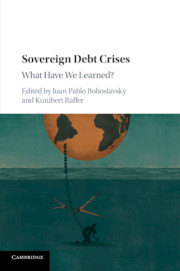Book contents
- Sovereign Debt Crises
- Sovereign Debt Crises
- Copyright page
- Dedication
- Contents
- Contributors
- 1 Introduction
- 2 Managing Public Debt Crisis in Argentina
- 3 Why Developing Countries Should Not Incur Foreign Debt
- 4 Ecuador’s 2008–2009 Debt Restructuring
- 5 Greece: An EU-Inflicted Catastrophe*
- 6 Grenada: A Small Island Developing State Needs New Ways Out of Its Debt
- 7 Iceland: A Human Rights-Sensitive Approach to Deal with Financial Crises
- 8 Indonesia’s 1997–1998 Economic Crisis
- 9 The Irish Sovereign Debt Crisis Post-2009
- 10 Short-Term Capital Controls and Malaysia’s Fast Recovery after the East-Asian Crisis
- 11 Sovereign Debt
- 12 Portugal’s Austerity Bailout
- 13 Don’t Waste a Serious Crisis*
- 14 Lessons from South Korea
- 15 The Spanish Crisis
- 16 Conclusions
- Index
3 - Why Developing Countries Should Not Incur Foreign Debt
The Brazilian Experience
Published online by Cambridge University Press: 16 November 2017
- Sovereign Debt Crises
- Sovereign Debt Crises
- Copyright page
- Dedication
- Contents
- Contributors
- 1 Introduction
- 2 Managing Public Debt Crisis in Argentina
- 3 Why Developing Countries Should Not Incur Foreign Debt
- 4 Ecuador’s 2008–2009 Debt Restructuring
- 5 Greece: An EU-Inflicted Catastrophe*
- 6 Grenada: A Small Island Developing State Needs New Ways Out of Its Debt
- 7 Iceland: A Human Rights-Sensitive Approach to Deal with Financial Crises
- 8 Indonesia’s 1997–1998 Economic Crisis
- 9 The Irish Sovereign Debt Crisis Post-2009
- 10 Short-Term Capital Controls and Malaysia’s Fast Recovery after the East-Asian Crisis
- 11 Sovereign Debt
- 12 Portugal’s Austerity Bailout
- 13 Don’t Waste a Serious Crisis*
- 14 Lessons from South Korea
- 15 The Spanish Crisis
- 16 Conclusions
- Index
Summary
This chapter aims at addressing the macroeconomic difficulties imposed to middle-income countries that adopt a growth model based on foreign savings (or current-account deficits) in opposition to mainstream arguments that defend the existence of benefits for both borrowers (developing countries) and lenders (developed countries). To illustrate the theoretical arguments, we used empirical evidence from the Brazilian economy. These difficulties are not only associated to growth of foreign debt, which can lead to external financial crises, but also mainly to a causal relation between the current-account balance and the exchange rate. The accumulation of external deficits leads to a chronic overvaluation of the exchange rate. This macroeconomic dynamic, in turn, reduces the competitiveness of domestic producers in relation to foreign ones, which weakens domestic productive structures, condemning these economies to a low growth rate. Even when the external deficits are financed by foreign direct investments, there is another difficulty caused by remittances out of the country, which reduce national income and domestic savings, in particular when these investments contribute little to expansion of gross fixed formation, as verified in the Brazilian case. We note that in the last 70 years of Brazil’s economy, the highest growth period (1947–72) was consistent with low levels of current-account deficits. From 1973 the pro argument of the benefits of foreign debt was definitely incorporated into economic policy. As a result, we observed an increase in external deficits, at the same time in which there was a slowdown in economic growth, including the occurrence of the debt crisis during the ’80s and the need for external financial assistance in the end of the ’90s and the beginning of the 2000s. More recently, although there is no interruption of foreign capital inflows, the negative effects of accumulation of external deficits must hinder a more robust economic recovery.
Information
- Type
- Chapter
- Information
- Sovereign Debt CrisesWhat Have We Learned?, pp. 31 - 47Publisher: Cambridge University PressPrint publication year: 2017
Accessibility standard: Unknown
Why this information is here
This section outlines the accessibility features of this content - including support for screen readers, full keyboard navigation and high-contrast display options. This may not be relevant for you.Accessibility Information
- 1
- Cited by
